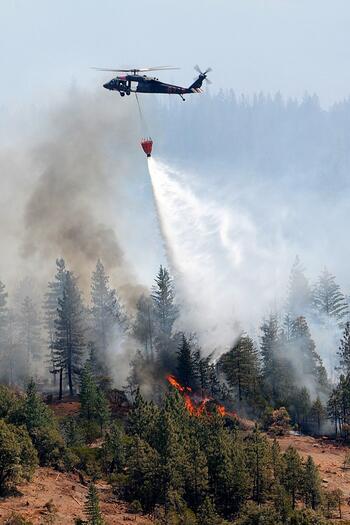
Someone in Bend must be reading this blog, or at least thinking along the same lines. In 2017, after the Wine Country fires had burned homes in Santa Rose, the Antiplanner noted that the problem was the homes were too dense and needed a buffer of low-density homes around them. I made the same point after the Camp Fire burned homes in Paradise.
Now Deschutes County is zoning a buffer between Bend and the national forest for low-density housing. The zone calls for one home every 2.5 acres, which is probably not dense enough — one home every acre would be sufficient and would make it more likely that homeowners would treat their entire properties to minimize fire risk.
The land that Deschutes County is zoning as a fire buffer is outside of Bend’s urban-growth boundary. Under Oregon land-use planning rules, lands outside of but adjacent to the boundary may be zoned “rural residential” with 5- to 10-acre minimum lot sizes. It is likely that the county is going for 2.5-acre lot sizes because it fears it couldn’t get away with one-acre lot sizes.
In addition to the large lot sizes, the new zoning will require homeowners and subdivisions to have “dedicated open space” and “wildfire prevention mitigation plans.” As the Antiplanner noted a decade ago, homes built to “shelter-in-place standards” can survive the worst wildfires. In fact, they are so safe that residents are encouraged to stay in their homes rather than evacuate. This is the type of development Deschutes County should encourage between the national forest and the city.
While many free-marketeers object to zoning of any kind, this is one situation where zoning creates huge positive externalities. If low-density development of a buffer area can protect more conventional Bend neighborhoods from suffering the fate of those in Santa Rosa, the benefits may outweigh the costs. In this particular case, the county is upzoning from the ultra-low-density zoning that preceded it, so the rural landowners benefit as well.
Ironically, after fires failed to harm homes in southern California shelter-in-place neighborhoods, a representative of the California Department of Forestry and Fire Protection criticized developers for building such homes because they encouraged people to live in fire-prone areas. But, as the fires in Santa Rosa, Paradise, Malibu, and elsewhere demonstrated, most of California is fire-prone; the solution is to build low-density fire-proof neighborhoods and use them as a buffer around denser cities.
This piece first appeared on The Antiplanner.
Randal O’Toole (rot@ti.org) is a senior fellow with the Cato Institute and author of the new book, Romance of the Rails: Why the Passenger Trains We Love Are Not the Transportation We Need, which was released by the Cato Institute on October 10.
Photo credit: The National Guard [Public domain], via Wikimedia Commons












